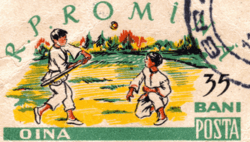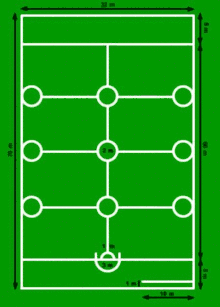Oină
Oină (Romanian pronunciation: [ˈoj.nə]) is a Romanian traditional sport, similar in many ways to baseball.[1]
 | |
| Highest governing body | Romanian Oină Federation |
|---|---|
| First played | 1370 (first documented) 1899 (modern rules) |
| Characteristics | |
| Contact | Yes, players are hit with the ball, but no body contact |
| Team members | 11 per side |
| Type | Outdoor |
| Equipment | Oină ball |
| Venue | Oină pitch |
| Presence | |
| Olympic | No |
History
The name "oină" was originally "hoina",[2] and is derived from the Cuman word oyn "game" (a cognate of Turkish oyun).[3]
The oldest direct mention comes from a diet manual of 1782 by medic István Mátyus, who talks about the health benefits of oina.[4]
In 1899, Spiru Haret, the minister of education decided that oină was to be played in schools in physical education classes. He organized the first annual oină competitions.
The Romanian Oină Federation ("Federaţia Română de Oină") was founded in 1932, and was reactivated at the beginning of the 1950s, after a brief period when it was dissolved.
Today, there are two oină federations: one in Bucharest, Romania and another one in Chișinău, Moldova.
Pitch

The pitch is a rectangle, 70m long by 32m wide divided into:
- the in game ("în joc") area, which is 60x32m
- the batting zone ("zona de bătaie") - 5m long - delimited from the in game area by the batting line
- the back zone ("zona de fund") - a 5m long safe zone during a run - delimited from the in game area by the back line
The attacking side player that has commenced a run will have to cross the following four lines in order:
- the start line (the left side of the batting line)
- the arrival line (the left side of the back line)
- the return line (the right side of the back line)
- the escape line (the right side of the batting line)
The in game area is further split into the advance and return triangles and squares. At the intersection of the lines inside the game area and the pitch limits or other lines within the game area, there are circles which determine the positions of the midfielders ("mijlocași") and side players ("mărginași"). The 1m and 3m semicircles are used for batting and serving. A waiting line is drawn for attacking players to wait their turn to bat.
Players
There are two teams of 11 players, one attacking side or "at bat" ("la bătaie") and one defending side or "at catch" ("la prindere"). The roles switch at half time.
The defending players are placed in the following positions:
- 3 midfielders ("mijlocași")
- 3 advance side players ("mărginași de ducere")
- 3 return side players ("mărginași de întoarcere")
- 1 back player ("fundaș") that is free to move within the back zone
- 1 forward player ("fruntaș") that is free to move within the batting zone
The attacking players change roles as the game progresses. The roles are chronologically ordered this way:
- waiting one's turn
- serving the ball
- batting
- waiting to enter the game (make a run)
- running the advance corridor
- staying in the back zone
- running the return corridor
Each team has a captain ("căpitan" or "baci""). The midfielder 2 is usually used as captain because he can throw the ball at an attacking player in any in game position. For this reason, the midfielder 2 is also known as a baci.
Each team has a maximum of 5 substitutes available.
Scope of the game
The teams have very different roles depending on whether they are at bat or at catch. At bat players are tasked to open a play and run the lanes until they cross the escape line. At catch players are tasked to hit the players running the lanes with the ball. There can be a maximum of 2 players running each lane at the same time. A player can be hit in both lanes once.
Rules
The team at bat is selected by a ritual where the players have to grab the bat, thrown by the referee, and the last one to be able to place at least 4 fingers on the bat wins. The game begins with the team at bat, with one of the players throwing the ball while another player of the same team has to hit it with a wooden bat ("bâtă") and send it as far as he can towards the adversary field. After that, if the ball is caught by the adversaries, the player can run (if he wishes, or if he is forced to run by the referee) the advance and return corridors/lanes ("culoarele de ducere și întoarcere"), without being hit by the defenders. If he stops the ball with his palm, it is not considered a hit. The player is not allowed to catch the ball, and he must release it immediately. If the player doing a run is hit he goes out of field and into the back zone, or he finishes his tasks, depending on which lane he is running.
Scoring
In game
At catch players score 2 points for each player hit with a ball, unless the ball touches the palm or the back of the palm.
At bat players score by batting beyond certain lines, like so:
- the ball crosses the 65m line in the air and does not go out of bounds (does not cross the lateral lines), whether or not the defense touches the ball in the air - 2 points
- the ball falls in the back zone - 2 points
- the ball is touched in the air by the defense, and goes out of bounds in the air from within the back zone - 2 points
- the ball goes out of bounds in the air from within the back zone without being touched by the defense - 1 point
- the ball crosses the 60m line (the back line) in the air and is caught by the defense - 1 point
- the ball crosses the threequarters line in the air and falls in the threequarters area - 1 point
- the ball goes out of bounds in the air from within the threequarters area - 1 point
- the ball is diverted out of bounds in the air from within the threequartees area by the defense - 1 point
- the ball falls on the threequarters area of the back line - 1 point
- the ball is diverted from within the threequarters area in front of the threequarters line by the defense and is not subsequently caught in the air - 1 point
Competition
Winning brings the team 3 points, a draw brings in 2 points, and the losing team will score 1 point. Quitting or elimination of the team will result in no points being awarded and a 0-9 loss. Running out of substitutes due to injuries will result in a 0-6 loss and 1 point being awarded, while if the same situation is due to the elimination of a player, the result will be a 0-9 loss and no points being awarded.
Ball
A spherical ball made of leather, filled with horse, pig, or bovine hair is used in oină. The ball is around 8 cm in diameter and 140 grams in senior games and around 7 cm in diameter and 100 grams in U-18 games.
Comparison with baseball
- Similar weight of the ball: around 140 grams for both
- Longer and slimmer bat for oină
- A game takes only 30 minutes for oină
- Oină teams have 11 players; Baseball teams have 9 players
- In oină, the defense can score by hitting the attacking players that are in game (running the lanes)
Competitions in Romania
All competitions are organized by the governing body, the Romanian Oină Federation ("Federaţia Română de Oină" - FRO).
The main competitions are:
- The National Championship
- The Romanian Cup
- The Romanian Supercup
- The National Junior Championship
Other competitions in 2010[5] are:
- "Dragu" Cup
- "Gherăiești" Cup
- "Antena Satelor" National Championship (junior)
- Federation Cup
- Border Police Cup
- "Monteoru" Cup
- "Cleopatra" Cup (beach oină)
- "Zarandului" Cup
- "Tătaru" Cup
- Village Cup
- "Antena Satelor" Cup
- various other junior and indoor oină competitions
A number of international events are organized:
- "Cronos" Cup (junior)
- International Festival of Sports Related to Oină
- Oină-Lapta Tournament
Internationalizing Oină
Oină and variants of the sport are also played in neighboring countries where there has been or still is a Romanian ethnic or cultural presence. As part of its program to bring oină to the spotlight again, the FRO has begun the process of creating an international federation.[6] A minimum of 3 national federations need to exist in order to form an international federation, and 2 exist already (the Romanian and Moldovan federations). The FRO has begun talks of founding oină clubs and federations in neighboring Bulgaria and Serbia,[7] and in Sweden.[8] Demonstration matches are to be held in Serbia.
References
- "The forgotten Romanian national sport that may have inspired baseball". Society for American Baseball Research. January 16, 2017. Retrieved June 23, 2018.
- "personalitati". froina.ro. Archived from the original on 27 March 2018. Retrieved 26 April 2018.
- oină Archived 2016-03-09 at the Wayback Machine, in Alexandru Ciorănescu, Dicționarul etimologic român, Universidad de la Laguna, Tenerife, 1958-1966.
- "Mitul oinei: Inventia sportului national (I)". ziare.com. Archived from the original on 27 March 2018. Retrieved 26 April 2018.
- "Archived copy". Archived from the original on 2010-11-08. Retrieved 2010-05-26.CS1 maint: archived copy as title (link) 2010 calendar
- "Archived copy". Archived from the original on 2010-02-20. Retrieved 2010-05-26.CS1 maint: archived copy as title (link) Romania and the Republic of Moldova place the foundation of the International Oină Federation
- http://froina.sportlocal.ro/blog/stiri.html#Oina%20ajunge%5B%5D
- http://froina.sportlocal.ro/blog/stiri.html#Turneu%20international%5B%5D